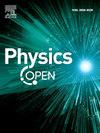"Effect of Cd2+ substitution on the structural, magnetic, and dielectric properties of Li-Ni spinel ferrite nanoparticles synthesized via sol-gel method."
IF 1.4
Q2 Physics and Astronomy
引用次数: 0
Abstract
Cadmium-doped lithium-nickel ferrite (CdxLi0.4-x/2Ni0.2Fe2.4-x/2O4) nanoparticles with doping content (x = 0.0 to 0.3) were synthesized via sol-gel auto combustion technique. The X-ray diffraction (XRD) studies have confirmed the cubic spinel structure. The crystallite size was calculated using Scherrer's formula, determined in the range of 37–29 nm. Field emission transmission electron microscopy (FETEM) further estimates particle size at ∼100 nm which is well suited with FESEM results, field emission scanning electron microscopy (FESEM) shows spherical, agglomerated particles with sizes ranging from 117 to 90 nm. The magnetic characteristics of the nanoparticles have been investigated through the application of a vibrating sample magnetometer (VSM). A reduction in saturation magnetization (Ms) is highlighted by the magnetic characterization from 68.18 emu/g to 48.55 emu/g, alongside an increasing coercivity (Hc) trend from 92.96 Oe to 109.06 Oe. Furthermore, the dielectric constant (ε′) decreases linearly at room temperature but rises with increasing temperature, indicating semiconducting behavior.
Cd2+取代对溶胶-凝胶法合成Li-Ni尖晶石铁氧体纳米颗粒结构、磁性和介电性能的影响
采用溶胶-凝胶自燃烧技术合成了掺杂量为x = 0.0 ~ 0.3的镉掺杂锂-镍铁氧体纳米粒子(CdxLi0.4-x/2Ni0.2Fe2.4-x/2O4)。x射线衍射(XRD)研究证实了立方尖晶石结构。晶体尺寸采用Scherrer公式计算,范围为37-29 nm。场发射透射电子显微镜(FETEM)进一步估计颗粒尺寸在~ 100 nm,这与FESEM的结果非常吻合,场发射扫描电子显微镜(FESEM)显示球形,团聚颗粒,尺寸范围为117至90 nm。利用振动样品磁强计(VSM)研究了纳米颗粒的磁性。饱和磁化强度(Ms)从68.18 emu/g下降到48.55 emu/g,矫顽力(Hc)从92.96 Oe上升到109.06 Oe。此外,介电常数ε′在室温下线性减小,但随温度升高而升高,表明其具有半导体性质。
本文章由计算机程序翻译,如有差异,请以英文原文为准。
求助全文
约1分钟内获得全文
求助全文
来源期刊

Physics Open
Physics and Astronomy-Physics and Astronomy (all)
CiteScore
3.20
自引率
0.00%
发文量
19
审稿时长
9 weeks
 求助内容:
求助内容: 应助结果提醒方式:
应助结果提醒方式:


